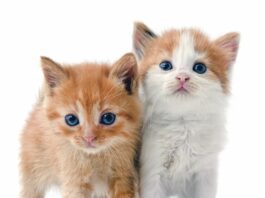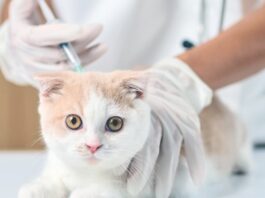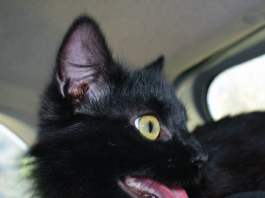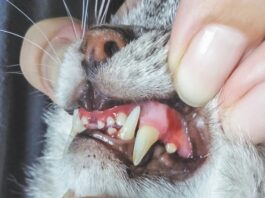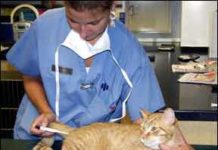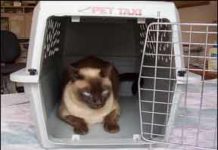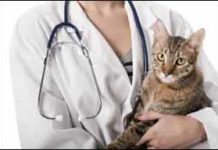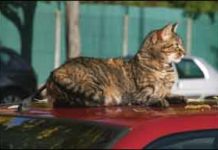Taking Your Cats Temperature
You may wonder: How exactly can I take my cat’s temperature without being bitten or scratched to smithereens? Obviously, you will need to do it carefully, and if possible, with a partner. Additionally, it’s a smart idea to first have a trained staff member at your veterinary hospital demonstrate the technique for you. There may be a time when your cat is recovering from an illness and you’ll be asked by your veterinarian to monitor her temperature, so it’s a useful skill to aquire.
Maladies of the Feline Ear
While most cats will go through life without experiencing a serious problem with their ears, owners should know that a variety of conditions — including congenital defects, infections, trauma, and age-related changes — can be extremely painful and may compromise an animal’s hearing. Most feline ear disorders are readily treatable and will not result in permanent hearing loss, notes James Flanders, DVM, an associate professor of surgery at Cornell University’s College of Veterinary Medicine. However, some conditions may render a cat partially or totally deaf, especially if they remain unrecognized and untreated.
Hairballs: Sometimes Serious
Every so often, your otherwise fastidious cat will do this alarming and somewhat disgusting thing. She’ll awake from a peaceful nap, rise up on her paws, retch convulsively for a moment or two, and spit up what may appear at first glance to be a damp clump. What the animal has disgorged — in the middle of your kitchen floor or, worse yet, in the middle of your prized Persian rug — is a trichobezoar, a wad of undigested hair that is commonly referred to as a hairball.Despite the term, disgorged hairballs are not always round. They are often slender and cylindrical, shaped more like a cigar or sausage than a ball.
Short Takes: August 2011
During the second World Conference on Veterinary Education in Lyons, France, an emphasis was placed on animal welfare and the background on the topic that graduating veterinarians need to achieve regardless of their location and training. “Vets can have a direct impact on the attitudes and behaviors of the general public towards animals as advisers to owners as well as to governments and corporations,” explained Ruth De Vere, head of education at the World Society for the Protection of Animals International (WSPA). “After this conference, where the world’s veterinary elite came together globally, I am hopeful that animal welfare will become an integral part of veterinary training.”
Ask Elizabeth: August 2011
In the U.S. — as in most of the Northern Hemisphere — rabies is a disease of wildlife which occasionally spills over to infect domestic animals and humans. Infection of our pet cats and dogs occurs when unvaccinated animals come into contact with infected wild animals; vaccination provides an important protection to our pets and makes an effective barrier between wildlife rabies and humans. All warm-blooded animals are susceptible to rabies; however, the virus in a particular geographic area is usually a distinct genetic variant that has adapted to preferentially infect a single dominant reservoir host.
Epilepsy: Inexplicable and Scary
Whether happily playing with its favorite toy, vigorously pursuing a tiny mouse, or frantically fleeing from a dangerous predator, all of your cats activities rely on the controlled transmission of electrical signals among the billions of nerve cells (neurons) that are jammed into its little brain. In a normal cat, the transmission - or firing - of these signals is well controlled within the central nervous system. These neurons either fire or are inhibited from firing according to an animals shifting needs and desires. In the brains of cats affected with the disorder known as epilepsy, however, this elegant process goes awry.
Ask Elizabeth: June 2011
I have had whiskers all my life, but I really took them for granted until recently. Whiskers just seemed like big, fat hairs to me! So what are they, exactly? Well, all of a cats fur grows from hair follicles in the epidermal layer of the skin. Whiskers are specially modified (big, fat) hairs that grow from very large follicles in specific locations. Of course, the most prominent whiskers are those that grow on the upper lips of the muzzle.
Earthquake and Tsunami Spared Cat Island
Japans "cat island" - known formally as Tashirojima - was found to be relatively intact after Marchs devasting 9-magnitude earthquake and resulting tsunami, according to Japan Earthquake Animal Rescue and Support. The small island is home to at least 100 people - mostly elderly - and many more cats. The animals are valued by the residents for their beauty, companionship and ability to keep the rodent population down in this fishing area.
Feline Blood Donors: Necessary
Blood can be the gift of life not just for us, but also for our cats. "A cat suffering severe injury or trauma may require blood transfusions," says Marjory Brooks, DVM, associate director of the coagulation section at Cornell Universitys Animal Health Diagnostic Laboratory. Other indications for transfusion include surgical complications and anemia caused by autoimmune disease, renal failure, chemotherapy, parasites in the intestinal tract or fleas. "Young kittens are especially at risk for blood-loss anemia caused by flea infestation," says Dr. Brooks. Cats that need plasma proteins to combat liver disease, clotting problems or rat poisoning may also require a transfusion.
Vomiting: When Is It Serious?
While youre watching your favorite television show in the family room, you hear a familiar retching sound from the kitchen. Boomer is vomiting up his dinner again. As you clean up the mess, you wonder if its just hair balls - or something more serious that requires a trip to the veterinarians office. Cats vomit for numerous reasons, ranging from benign dietary indiscretion to potentially fatal systemic diseases such as renal failure or hyperthyroidism. The experts say that cat owners should pay close attention to a cat that becomes sick to his or her stomach.
Why Theres a Decline in Veterinary Visits
Cat and dog veterinary visits have been declining over the past several years, and a new study might explain why. According to the Bayer Veterinary Care Usage Study, the reasons include: the economic impact of the recession, fragmentation of veterinary services, consumers substituting Internet research for office visits, cat resistance to vet visits, perception among pet owners that regular medical check-ups are unnecessary and the cost of care.
Short Takes: March 2011
Cornell University Veterinary Specialists (CUVS) welcomed its first patients in January, 2011. The satellite referral and 24-hour emergency care hospital located at 880 Canal Street in Stamford, CT, leverages the resources of the nations leading veterinary college, Cornell Universitys College of Veterinary Medicine, with those that the best of specialty private practice can offer for the benefit of pets, owners and the veterinary profession.


